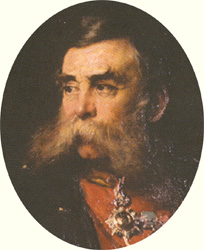Lintorn Simmons
| Sir Lintorn Simmons | |
|---|---|

Sir Lintorn Simmons
|
|
| Born | 12 February 1821 Lower Langford, Somerset |
| Died | 14 February 1903 (aged 82) Hawley, Hampshire, England |
| Allegiance |
|
| Service/branch |
|
| Years of service | 1837–1888 |
| Rank | Field Marshal |
| Commands held |
Royal Engineer Establishment Royal Military Academy Royal Engineers |
| Battles/wars | Crimean War |
| Awards |
Knight Grand Cross of the Order of the Bath Knight Grand Cross of St Michael and St George |
| Other work | Governor of Malta |
Field Marshal Sir John Lintorn Arabin Simmons GCB GCMG (12 February 1821 – 14 February 1903) was a British Army officer. Early in his career he served as Inspector of Railways, Secretary of the Railways Commission and then Secretary of the Railway Department under the Board of Trade. He went on to be British Commissioner with the Turkish Army providing advice to General Omar Pasha during the Crimean War. He assisted the Turks at the defence of Silistra and then led them at the Battle of Giurgevo before landing with them at the Battle of Eupatoria and remaining with them for the Siege of Sevastopol. After that he became British Consul in Warsaw, Commander, Royal Engineers at Aldershot and then Director of the Royal Engineer Establishment in Chatham. He went on to be Lieutenant-Governor of the Royal Military Academy and subsequently Governor of the Academy. His last appointments were as Colonel Commandant of the Royal Engineers, as Inspector General of Fortifications and then as Governor of Malta.
Born the fifth son of Captain Thomas Frederick Simmons, RA and Mary Simmons (née Perry), Simmons was educated at Elizabeth College, Guernsey and the Royal Military Academy, Woolwich. He was commissioned as a second lieutenant in the Royal Engineers on 4 December 1837 and promoted to lieutenant on 15 October 1839. He was then deployed to Canada where he carried out survey work on the disputed border with the United States of America.
...
Wikipedia
